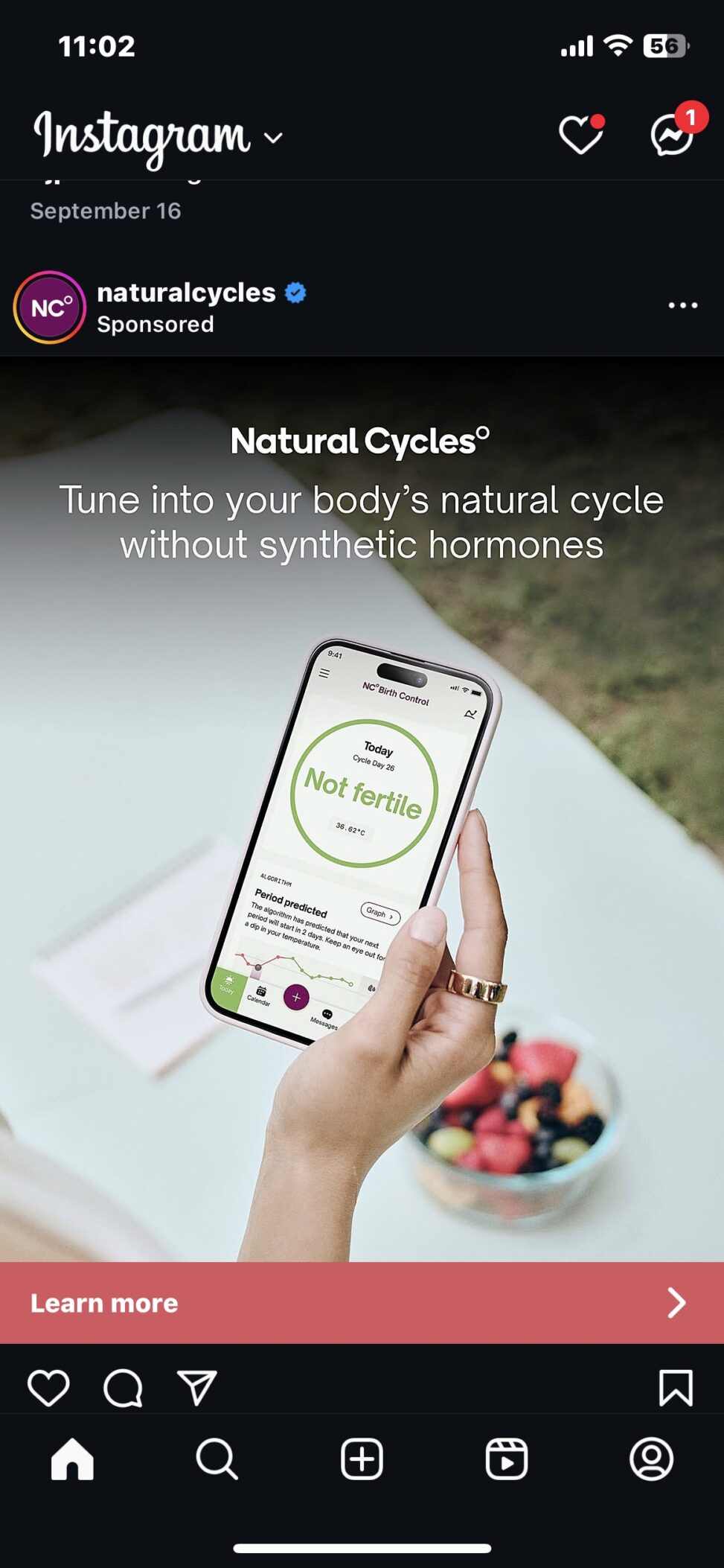Analyzing Advertising:
Natural Cycles Birth Control Ad
Isabelle Catenaccio
T00660180
Introduction to Visual Culture
Course Number: 1500_01
September 30, 2025
Overview of Natural Cycles
Founded in 2013, Natural Cycles has been providing its users with the opportunity to track their fertility cycles through temperature data collected on their Oura Ring. The company’s origins stemmed from the founders, Dr. Elina Berglund and Dr. Raoul Scherwitzl’s, desire to start a family. The empowerment she felt while taking charge of her own body was something she wanted to share with the world. The ad itself is still based, as it was purchased with the hopes that impressions and downloads would be high. Compared to time-based advertising, still based ads allow users to engage with it in various ways, such as a bus poster, or any platform that allows users to post photos.
Description
White can be seen from the top left-hand corner, spanning diagonally to the bottom right-hand corner, and throughout the bottom of the background. A pop of green emerges from the top right-hand corner, matching the bright green font on the white screen of the cell phone in the foreground. Although slightly blurred, the pop of color from the fruit instantly draws your eyes to the background, helping you find the conveniently located Oura Ring. As the Oura Ring is not prominently featured in the ad, it is a smart way for the company to subliminally introduce it to you. The time stamp on the user’s phone, combined with the brightness of the grass indicates she is having a morning picnic, with a bowl of fruit for breakfast. The journal to the bottom left of the phone indicates she is either journaling general thoughts, or tracking her fertility cycle from the app. Alongside the ability to track your cycle, Natural Cycles provides various themed blogs with topics spanning from Mental Health to Healthy Eating Tips. The elements convey the impression that the model has been influenced to live a healthier lifestyle due to the app’s blog suggestions. The advertising therefore sends an indirect message to the viewer that by using Natural Cycles, you will lead a healthier life.
Analysis
The sleekness and simplicity of both the iPhone and the Oura Ring promote a feeling of modernity. The ad features the pink iPhone 15 Pro, a product that may be too expensive for the average person. The added element of it being pink adds to the notion that this is a female-driven app. The design of the ring is aesthetically pleasing, fitting to any outfit you’d want. With only the bowl of fruit and the journal placed upon the white blanket, you gain a sense of cleanliness and routine. The fruit being placed in a glass bowl rather than a container further indicates that. Through the constant practice of researching blogs that apply to concerns you are facing, you will be able to develop discipline and routine.
Evaluation
Once combined, all the elements appeal to a demographic that values self-care and health. The prominent “Not Fertile” on the iPhone will instantly catch female users’ attention, especially if that is an issue they struggle with. As a 23-year-old female, I am part of their target demographic. Natural Cycles offers a broad range of information from period, pregnancy, and sexual education. Through targeting the 20- to 30-year-old demographic, the company can either prevent the spread of misinformation for the younger users or build on pre-existing information obtained by the experienced users. If the sleek, clean styling of the advertising is what attracted them, the website will only exemplify that. Imagery used in the advertising is not overstimulating, it is simple in design and can hold the attention span of the modern viewer. By combining these factors with the design choices previously mentioned, the advertisement manages to appeal to its intended demographic of young adults.
Personal Tracking in a Digital Age
Through his studies, Larry Bailey is determined to, “prove that female reproductive health apps and supportive fertility technologies harness body temperature and menstrual cycle records to algorithmically determine the fertile window.” (Bailey, 2021). Bailey emphasizes both the pros and cons of reproductive tracking apps. While he acknowledges that users are given the ability to make their own decisions, and optimize their ability to conceive, all while feeling empowered. According to Bailey, empowerment is generated through Datafication, the process of converting real world experiences into quantifiable data which can generate new value. He also mentions the potential drawbacks. Users struggling with gender identity are further reinforced into gendered stereotypes. The accuracy and privacy of the data provided is crucial to its user as, “imprecise data… may be deleterious to chances of conceiving.” (Bailey, 2021). Bailey constitutes cycle and pregnancy trackers as the digital fabric of reproductive technologies, highlighting their importance for women.
In 2024, a study was conducted by UCLA, MIT, and Natural Cycles to identify the longitudinal changes in sexual desires and attractions following the discontinuation of hormonal contraceptives (HC’s) to acknowledge the timeline of recovery for sexual function. The sample group consisted of women who had discontinued HC’s and began using Natural Cycles. Gassen J., et al (2024) note that sexual side effects are the most common reasons for women discontinuing HC’s. The user guidance, and FDA approved status of Natural Cycles appeals to women searching for a non-invasive replacement. Results reflected this note as a significant statistical increase in sexual desires was witnessed following the discontinuation of HC’s.
Conclusion
While the claims made by Natural Cycles may not be for environmental benefits, they may hold marketing bias. As a non-hormonal product that provides funding to research, they are able to highlight the side effects of their HC competitors. A potential for bias may be present in the previous study as multiple authors are affiliated with Natural Cycles. When a study is centered on the side effects of your competitor, and the solution is your product/platform, marketing bias may arise.
BIBLIOGRAPHY
Bailey, Larry. “The Digital Fabric of Reproductive Technologies: Fertility, Pregnancy, and Menstrual Cycle Tracking Apps.” Journal of Research in Gender Studies 11, no. 2 (2021): 126–38.
Gassen, Jeffrey, Summer Mengelkoch, et al. “Longitudinal Changes in Sexual Desire and Attraction among Women Who Started Using the Natural Cycles App.” Hormones and Behavior 162 (June 2024): 105546. https://doi.org/10.1016/j.yhbeh.2024.105546.


Anudi Kumarasinghe
I think Isabelle did a really good job describing the advertisement and explaining how the company tries to look eco-friendly through the use of natural colors and images. Their analysis clearly showed that they understood how the ad uses green-washing to make the brand seem sustainable, even if it might not actually be. I liked how they talked about the emotional appeal of the ad and how it connects the product to ideas like purity and nature — that was a strong point.
Their main argument was that the company uses visual cues and positive messaging to make consumers believe the product is environmentally responsible. They also used one scholarly source to back up their ideas about green marketing, which made their analysis more credible. However, I think they could have included more academic or real-world examples to show whether the company’s claims were true or just marketing.
One thing they might have missed is discussing how consumers often want to believe these ads because it makes them feel like they’re making good choices. That’s an important part of green-washing too. Overall, it was a well-written and thoughtful analysis — just a bit more evidence and deeper critique would make it even stronger.